Litter, graffiti, gum, needles, vomit, poop.
Austin Bertucci has seen—and cleaned—it all and more working as San Luis Obispo's "downtown ambassador" over the past few years. Donning a Downtown SLO cap, polo shirt, trash picker, and unflappable smile, Bertucci spends his weekdays from 10 a.m. to 6 p.m. traversing Higuera, Marsh, and Monterey streets, his eyes peeled for something to clean up and someone to help out.
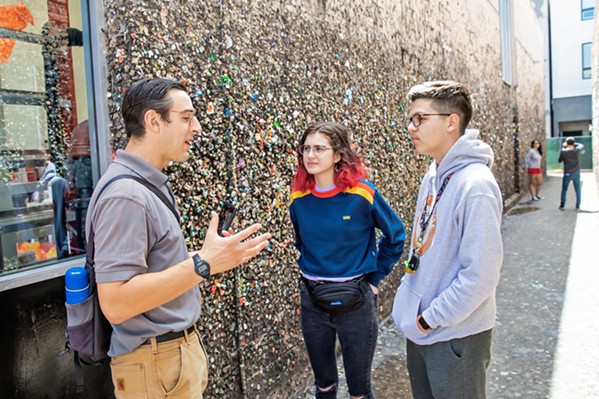
- Photos By Jayson Mellom
- GUM HISTORY Austin Bertucci (left) explains the origins of Bubblegum Alley to two visitors from Phoenix, Arizona. Part of his job as the Downtown SLO ambassador is to engage with tourists about the city.
"Howdy folks, how's it going?" Bertucci chipperly asks a group of four walking down Higuera Street on a Friday morning in May. A minute later, he's offering to take a photo of a couple from Phoenix, Arizona, in Bubblegum Alley.
"This started in 1959," Betucci says about the notorious gum-plastered walls. "By the '60s it was known as this place you put your gum."
Bertucci cleans the sidewalks, trash cans, benches, street signs, and tree grates. He talks with locals, tourists, and downtown business owners and employees. He interacts with transients—checks on their well-being, reminds them of city rules, and directs them to services. He reports illegal or unsafe activities he observes to the police, from vandalism to hard drug use.
"I'm a face of downtown SLO," Bertucci tells New Times about his job.
That role can be a lot of fun (like explaining Bubblegum Alley), a little scary (like encountering unsafe behaviors), and sometimes pretty gross.
"Any sort of feces I'll remove," he says. "We try to follow city ordinances as best we can, and there's an ordinance against letting water go into the gutter. What I have to do is use towels to kind of soak whatever it is—say it's puke, poop, ice cream—as I'm removing it. I have to put towels to soak it up."
"It can be overwhelming," he adds with a chuckle. "There's a lot that goes on downtown."
Bertucci's job is also overwhelming in part because he's the only guy doing it. Downtown business leaders hope to change that soon.
The Downtown SLO association, which employs Bertucci as its ambassador, is currently working to muster support from downtown property owners to start a new Property-Based Improvement District (PBID). That district, if formed over this summer and fall, would collect assessments from about 125 property owners in its boundaries to be used to hire four to five more ambassadors like Bertucci. Beginning in January 2020, Downtown SLO could have a full-fledged "clean and safe" program.
"We'd have ambassadors on the ground seven days a week," explained Bettina Swigger, CEO of Downtown SLO. "Seeing the success we've had with the one ambassador—he's beloved by the business owners. We know we need more."
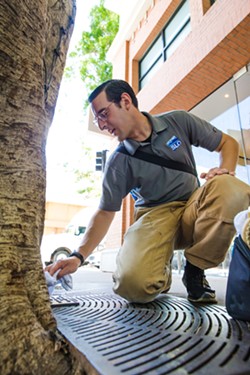
- Photos By Jayson Mellom
- CLEAN STREETS Downtown SLO's current ambassador, Austin Bertucci, cleans pretty much everything downtown—benches, trash cans, plaques, and more—and even does a little tree trimming.
Supporters of the PBID—which include the city of SLO and the SLO Chamber of Commerce—view the effort as an opportunity to make progress on long-standing concerns about safety and cleanliness downtown, at a moment when two large hotels are set to open on its streets to worldwide visitors. Its opponents argue that the district is an inequitable approach to accomplish unrealistic or misguided goals.
"This initiative is an ineffective solution to the issues at hand," potential PBID member Rachael Drake said at a May 21 SLO City Council meeting. "Raising taxes by a select few properties, whether business owners or homeowners, to fund a cleaner downtown, when everyone enjoys downtown, doesn't seem right."
In order to pass, the PBID must earn majority approval from the property owners in its boundaries—first in a petition drive, and then in a mail-in vote. It's currently in the petition-signing phase, and the outcome remains up in the air. A previous proposal, with broader boundaries, failed to garner enough signatures earlier this year.
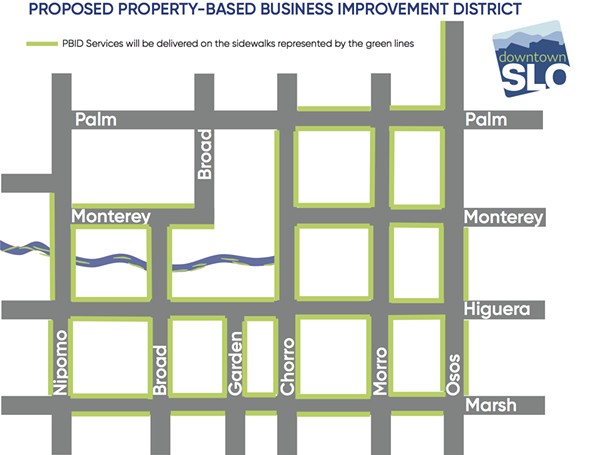
- Map Courtesy Of Downtown SLO
- BOUNDARIES The proposed boundaries for a Property-Based Improvement District in downtown SLO are outlined in green. If approved by the majority of properties within it, the district would generate $400,000 per year for Downtown SLO.
'Where we need to go'
The germ of the idea to start a PBID and grow the ambassador program came out of a survey of the downtown business community in 2017.
In it, more than 300 respondents concluded that parking, homelessness and unsafe behaviors, and general cleanliness were downtown's top problems.
With the city in charge of providing parking, Downtown SLO zeroed in on the latter two concerns for action.
"It's an issue," Swigger said specifically about safety and cleanliness. "We do see some drug dealing going on. We see needles show up. And that's not the image we want to project for our beautiful, wholesome downtown. We want people to be welcome here, not feel threatened."
First formed in 1975 as a Business Improvement Association, Downtown SLO is best known as the group behind Thursday Farmers' Markets and summer Concerts in the Plaza. The current business assessments that fund the organization, though, don't provide enough revenue to launch a clean and safe program beyond Bertucci. So, in the wake of the 2017 survey, a consultant recommended a PBID.
"Honestly, none of us had heard of it," said Pat Arnold, president of Downtown SLO, owner of the downtown Creamery property, and CEO of Covelop. "We did more outreach and in September did a trip to Ventura and Pasadena and were able to see PBIDs in action. ... We really realized this is where we need to go."
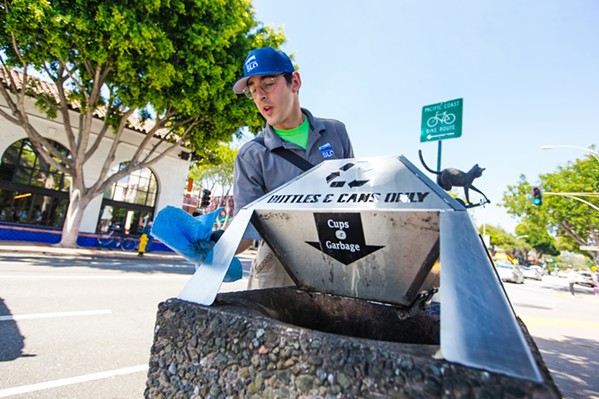
- Photos By Jayson Mellom
- CLEAN STREETS Downtown SLO's current ambassador, Austin Bertucci, cleans pretty much everything downtown—benches, trash cans, plaques, and more—and even does a little tree trimming.
PBIDs are not all that common in downtowns, but they're not rare, either. About 40 PBIDs exist in California, and more than 1,000 are nationwide, according to Downtown SLO. The closest PBID to SLO is in downtown Ventura. A PBID is valid for five years, after which its members must vote again to renew it. A PBID's boundaries can also be adjusted after five years.
On their field trip south, Downtown SLO leaders said that they were impressed by the cleanliness of those cities and the teams of ambassadors who worked their streets.
"It's been amazing to see what they have," Swigger said. "[In Ventura] we saw two of their ambassadors on Sunday morning. They're out sweeping, cleaning up stuff; you can't even see a leaf on the sidewalk, it's so clean. There's no graffiti. It just feels different. It doesn't feel antiseptic, it just feels cared for."
With help from Kentucky-based consultant Block by Block, which runs clean and safe programs in downtowns across the country (and would run SLO's), Downtown SLO started putting together a PBID proposal.
Initially, the proposed district included in its boundaries segments of Higuera and Monterey streets that extended several blocks past Santa Rosa Street, out of the heart of downtown. A proposed annual budget of $800,000 would have funded an eight-member ambassador team.
But that version of the district quickly ran into opposition. Property owners on the periphery, particularly, didn't see the benefit of paying into a program that they felt would only really help downtown's nucleus. So Swigger and Downtown SLO went back to the drawing board, and decided to essentially cut the scope of the PBID in half.
"We learned a lot," Swigger said. "We didn't hear anybody who said they thought the services were not needed. They just disagreed about where the services should be provided and, of course, who should pay for it."
Now, the revised PBID stretches from Nipomo Street to Osos Street (the general boundaries of Farmers' Market), and from Palm Street to Marsh Street.
The property assessments—which are based on a calculation combining lot square footage, building square footage, and linear frontage—would net a total of $400,000 per year, to fund a program with four to five ambassadors.
An owner of a 2,500-square-foot commercial building with a 40-foot linear frontage would pay about $715 annually into the PBID. Single-family residences and nonprofit owners would get special rates—$300 maximum assessments on single-family homes and 50 percent discounts for nonprofits.
To those who believe in the benefits of launching a clean and safe program, the PBID represents a chance to take a proactive step on improving the downtown environment.
"I see it as an opportunity for us to address issues that a lot of people mention, instead of just whining about them," said Laura Mullen, president of the HumanKind Fair Trade on Monterey Street. "I think we definitely need more people like Austin [Bertucci]—he's just fabulous. To think of what could happen if we had more Austins."
Eyes and ears
The team of downtown ambassadors, if assembled in a PBID-funded program, would split into two separate groups, one focused on cleaning and the other on outreach.
One of the most important and sensitive responsibilities of the outreach ambassadors would be to develop productive and positive relationships with the transient population downtown.
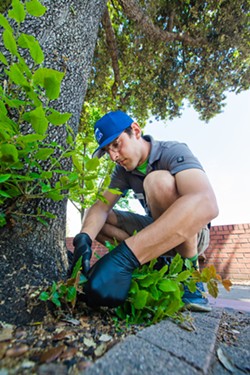
- Photos By Jayson Mellom
- CLEAN STREETS Downtown SLO's current ambassador, Austin Bertucci, cleans pretty much everything downtown—benches, trash cans, plaques, and more—and even does a little tree trimming.
That's a task that Bertucci has successfully embraced throughout his years on the job, according to Downtown SLO.
"The calm and respectful interactions he has with those people directly affects how they function downtown," said Downtown SLO President Arnold. "There are some he can't click with, but he's able to talk to them. His presence and demeanor just lowers the tension downtown."
With additional ambassadors on the streets, under a structured program run by Block by Block, Downtown SLO believes it can make bigger strides in both helping homeless individuals and at the same time starting to reverse perceptions about safety downtown.
"I just know I have a lot of people make comments on the homeless—'I don't feel comfortable,'" Arnold said. "Perception is reality. It's tough to turn that around."
The presence of ambassadors not only has the chance to create a safer-feeling environment for visitors, Arnold argued, it can also provide resources to those needing help. Clean and safe programs, like the one SLO leaders saw in Ventura, keep ambassadors in close contact with local service providers and shelters.
"They're very keyed in with Ventura mental health," Arnold said. "Their ambassadors can actually check people into their homeless shelter. It's not a person calling the front desk."
Grace McIntosh, deputy director of CAPSLO, which operates the new 40 Prado Homeless Services Center in SLO, told New Times she supported alternative methods to address homelessness downtown outside of law enforcement—and hoped CAPSLO could have a "collaborative partnership" with Downtown SLO if the ambassador program forms.
"Any and all opportunities that homeless individuals can have to know about what resources are available, but not only that, get assistance in accessing those resources ... is great," McIntosh said.
The SLO Police Department is also in support of the plans for a PBID. Calling ambassadors "extra eyes and ears," department officials said their presence would help contribute to a more secure downtown environment.
"Whether it's a quick clean-up of graffiti on a trash can or a sticker on a pole," SLOPD Capt. Brian Amoroso told New Times, "some of those crimes are what we called the broken window theory. If you leave graffiti on a trash can today, tomorrow there'll be three trash cans graffitied. ... It tends to grow if you tolerate it."
Amoroso also discussed how SLOPD has found success this year working with a mental health professional on its Community Action Team on homelessness. While a downtown ambassador wouldn't have nearly the same level of expertise as a social worker, having another street-clothed authority figure interacting with the homeless, trying to build trust and extend help, would be a positive step, he said.
"No matter how nice or friendly a police officer may be, there's still the overall perception of who we are and what we're wearing, and we're aware of that," Amoroso said.
Costs, equity, and parking
On June 7, in Downtown SLO's office on Chorro Street, a few dozen downtown property and business owners convened to hear an informational presentation about the PBID and ambassador program. In attendance, as skeptics, were Palm Theatre owner Jim Dee and his neighbor, Paul Kwong, of Mee Heng Low Noodle House.
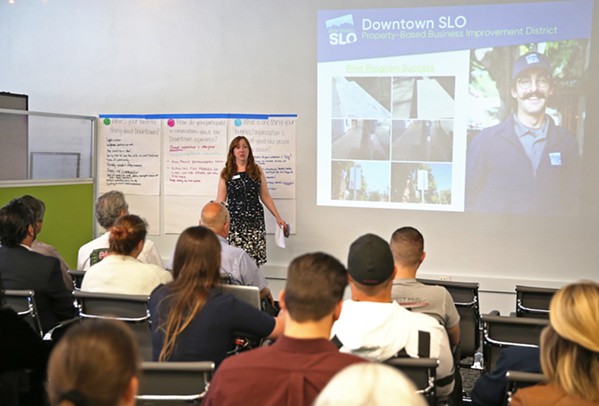
- Photos By Jayson Mellom
- MAKING THE PITCH Bettina Swigger, CEO of Downtown SLO, gives a presentation to downtown property and business owners on June 7 about the benefits of forming a Property-Based Improvement District.
Both business owners say they've been hit hard by the construction of the neighboring Hotel San Luis Obispo. After three long years of construction, the 78-room luxury hotel is set to open sometime this month, hosting up to 350 guests—the same guests that Downtown SLO hopes its future ambassadors will help welcome.
Dee lamented that irony and what he feels is his and downtown's biggest unsolved issue: parking.
"My building's getting thrashed and now they're asking me to pay money to beautify downtown," Dee told New Times on June 7. "The bottom line is these hotels have taken away parking."
While many downtown and SLO city groups have been supportive of the push for a PBID, some members like Dee and Kwong aren't connecting with the efforts, and will vote "no." Others, too, are arguing that the burden of a clean and safe downtown should not have to fall on the shoulders of a few dozen property owners.
"There's no question the proposed PBID is something that's needed," resident Fred Vernacchia said to SLO City Council members on May 21. "The problem I'm having is that this really should be a city-provided service, not something that should be provided by a private organization. ... The downtown area is a resource for all people."
In response to those arguments, SLO city officials have countered that the city is making "significant" investments in the downtown area. In its recently adopted 2019-21 financial plan, the City Council named downtown vitality as a major city goal, investing about $1 million in services to the downtown in 2019-20.
"We've got the bike [police] officers assigned to downtown, street sweeping, tree maintenance, several million [dollars] of capital investments," SLO Deputy City Manager Greg Hermann told New Times. "When you think about the ambassador program, that's in addition to, not a replacement of, the services provided by the city."
Amid grumbles that the PBID assessment just adds more to the already increasing costs of doing business downtown, Downtown SLO President Arnold said he doesn't believe it'll be a backbreaker for owners or tenants—on the contrary, he believes it's a bargain.
"When you're talking about rents that range from $1.50 to $5 per foot, and we're talking about $0.02 to $0.04 per foot [for the PBID], it's hard to argue that it will make a significant impact to the bottom line," Arnold said. "That small charge, though, will bring out a huge change in terms of working to improve cleanliness, safety, and the vitality of our downtown. ... At the end of the day, I don't think the PBID will be a determining factor in pricing the local small businesses out." Δ
Assistant Editor Peter Johnson can be reached at [email protected].
Comments (10)
Showing 1-10 of 10